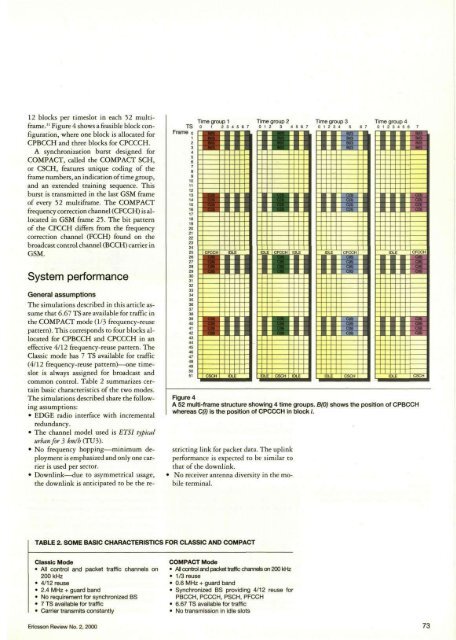ericssonhistory.com
ericssonhistory.com
ericssonhistory.com
- No tags were found...
You also want an ePaper? Increase the reach of your titles
YUMPU automatically turns print PDFs into web optimized ePapers that Google loves.
12 blocks per timeslot in each 52 multiframe."Figure 4 shows a feasible block configuration,where one block is allocated forCPBCCH and three blocks for CPCCCH.A synchronization burst designed forCOMPACT, called the COMPACT SCH,or CSCH, features unique coding of theframe numbers, an indication of time group,and an extended training sequence. Thisburst is transmitted in the last GSM frameof every 52 multiframe. The COMPACTfrequency correction channel (CFCCH) is allocatedin GSM frame 25. The bit patternof the CFCCH differs from the frequencycorrection channel (FCCH) found on thebroadcast control channel (BCCH) carrier inGSM.System performanceGeneral assumptionsThe simulations described in this article assumethat 6.67 TS are available for traffic inthe COMPACT mode (1/3 frequency-reusepattern). This corresponds to four blocks allocatedfor CPBCCH and CPCCCH in aneffective 4/12 frequency-reuse pattern. TheClassic mode has 7 TS available for traffic(4/12 frequency-reuse pattern)—one timeslotis always assigned for broadcast and<strong>com</strong>mon control. Table 2 summarizes certainbasic characteristics of the two modes.The simulations described share the followingassumptions:• EDGE radio interface with incrementalredundancy.• The channel model used is ETSI typicalurban for 3 kmlh (TU3).• No frequency hopping—minimum deploymentis emphasized and only one carrieris used per sector.• Downlink—due to asymmetrical usage,the downlink is anticipated to be the re-Figure 4A 52 multi-frame structure showing 4 time groups. B(0) shows the position of CPBCCHwhereas C(i) is the position of CPCCCH in block /'.stricting link for packet data. The uplinkperformance is expected to be similar tothat of the downlink.No receiver antenna diversity in the mobileterminal.TABLE 2. SOME BASIC CHARACTERISTICS FOR CLASSIC AND COMPACTClassic Mode• All control and packet traffic channels on200 kHz• 4/12 reuse• 2.4 MHz + guard band• No requirement for synchronized BS• 7 TS available for traffic• Carrier transmits constantlyCOMPACT Mode• All control and packet traffic channels on 200 kHz• 1/3 reuse• 0.6 MHz + guard band• Synchronized BS providing 4/12 reuse forPBCCH, PCCCH, PSCH, PFCCH• 6.67 TS available for traffic• No transmission in idle slotsEricsson Review No. 2, 2000 73















